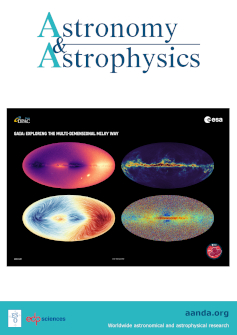Planet-driven spirals in protoplanetary discs: Limitations of the semi-analytical theory for observations
IF 5.4
2区 物理与天体物理
Q1 ASTRONOMY & ASTROPHYSICS
引用次数: 0
Abstract
Context. Detecting protoplanets during their formation stage is an important but elusive goal of modern astronomy. Kinematic detections via the spiral wakes in the gaseous disc are a promising avenue to achieve this goal.Aims. We aim to test the applicability of a commonly used semi-analytical model for planet-induced spiral waves to observations in the low and intermediate planet mass regimes. In contrast to previous works that proposed using the semi-analytical model to interpret observations, in this study we analyse for the first time both the structure of the velocity and density perturbations. Methods. We ran a set of FARGO3D hydrodynamic simulations and compared them with the output of the semi-analytic model in the code WAKEFLOW. We divided the disc into two regions. We used the density and velocity fields from the simulation in the linear region, where density waves are excited. In the non-linear region, where density waves propagate through the disc, we then solved Burgers’ equation to obtain the density field, from which we computed the velocity field.Results. We find that the velocity field derived from the analytic theory is discontinuous at the interface between the linear and nonlinear regions. After ~0.2 rp from the planet, the behaviour of the velocity field closely follows that of the density perturbations. In the low mass limit, the analytical model is in qualitative agreement with the simulations, although it underestimates the azimuthal width and the amplitude of the perturbations, predicting a stronger decay but a slower azimuthal advance of the shock fronts. In the intermediate regime, the discrepancy increases, resulting in a different pitch angle between the spirals of the simulations and the analytic model.Conclusions. The implementation of a fitting procedure based on the minimisation of intensity residuals is bound to fail due to the deviation in pitch angle between the analytic model and the simulations. In order to apply this model to observations, it needs to be revisited so that it can also account for higher planet masses.原行星盘中的行星驱动螺旋:半解析理论对观测的限制
背景。探测处于形成阶段的原行星是现代天文学的一个重要但难以实现的目标。通过气态圆盘中的螺旋波进行运动学探测是实现这一目标的一个很有希望的途径。我们的目的是测试行星诱发螺旋波的常用半分析模型对中低行星质量观测的适用性。与之前提出使用半解析模型来解释观测结果的工作不同,在这项研究中,我们首次分析了速度和密度扰动的结构。研究方法我们运行了一组 FARGO3D 流体动力模拟,并与 WAKEFLOW 代码中半解析模型的输出结果进行了比较。我们将圆盘分为两个区域。在密度波被激发的线性区域,我们使用了模拟得到的密度场和速度场。在密度波在圆盘中传播的非线性区域,我们求解了布尔格斯方程,得到了密度场,并据此计算出了速度场。我们发现,从解析理论得出的速度场在线性区和非线性区的交界处是不连续的。在距离行星约 0.2 rp 之后,速度场的行为与密度扰动密切相关。在低质量极限,尽管分析模型低估了扰动的方位角宽度和振幅,预测了冲击前沿较强的衰减但较慢的方位角前进速度,但分析模型与模拟结果在质量上是一致的。在中间阶段,差异增大,导致模拟和分析模型的螺旋俯仰角不同。由于分析模型与模拟结果的俯仰角存在偏差,基于强度残差最小化的拟合程序必然会失败。为了将这一模型应用于观测,需要对其进行重新审视,使其也能考虑到更高的行星质量。
本文章由计算机程序翻译,如有差异,请以英文原文为准。
求助全文
约1分钟内获得全文
求助全文
来源期刊

Astronomy & Astrophysics
地学天文-天文与天体物理
CiteScore
10.20
自引率
27.70%
发文量
2105
审稿时长
1-2 weeks
期刊介绍:
Astronomy & Astrophysics is an international Journal that publishes papers on all aspects of astronomy and astrophysics (theoretical, observational, and instrumental) independently of the techniques used to obtain the results.
文献相关原料
| 公司名称 | 产品信息 | 采购帮参考价格 |
|---|
 求助内容:
求助内容: 应助结果提醒方式:
应助结果提醒方式:


